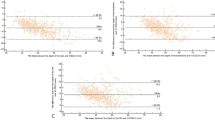Abstract
Purpose
Despite the many benefits of percutaneous thoracic sympathectomy, it also has serious complications such as pneumothorax. This study was conducted in order to determine the safe percutaneous entering window and angles for the needle during T2 and T3 thoracic sympathectomy avoiding pneumothorax.
Methods
Transverse section of CT images that crosses at the middle of the T2 or T3 vertebral body was selected. Medial and lateral imaginary lines were drawn from the dorsoventrally midpoint on the lateral surface of the vertebral body (v) to the skin. The medial one was drawn to the skin medially as much as possible tangent to the vertebral body (vM). The lateral one was drawn to the skin tangent to parietal pleura (vL). c was defined as the point where the midsagittal line meets the skin. The distance cM and cL, the angle aM and aL made between the midsagittal line and vM or vL lines were measured. To determine the relations between patients’ covariates and measured data, mixed-effect population analysis was performed for the cL, aL, and vL.
Results
In males, the mean values of cL were 85.3 and 79.2 mm for T2 and T3, respectively. In females, they were 71.5 and 63.7 mm for T2 and T3, respectively. Population analysis revealed that cL was best described with age, weight, gender covariates, and interindividual variability. The aL was best described with BMI and gender covariates.
Conclusions
The covariates’ relationship and interindividual variability resulting from the mixed-effect analysis enhanced individual prediction for safe widows.



Similar content being viewed by others
References
Ohseto K. Efficacy of thoracic sympathetic ganglion block and prediction of complications: clinical evaluation of the anterior paratracheal and posterior paravertebral approaches in 234 patients. J Anesth. 1992;6:316–31.
Straube S, Derry S, Moore RA, Cole P. Cervico-thoracic or lumbar sympathectomy for neuropathic pain and complex regional pain syndrome. Cochrane Database Syst Rev. 2013;9:CD002918.
Wilkinson HA. Hand edema after cervical fusion. JAMA. 1983;249:652 (letter).
Wilkinson HA. Percutaneous radiofrequency upper thoracic sympathectomy. Neurosurgery. 1996;38:715–25.
Hirose M, Tabata M, Sakai M, Takeuchi K. C-arm fluoroscopic cone-beam CT for guidance of chemical thoracic sympathectomy. J Anesth. 2011;25:142–3.
Ohseto K. Contrast radiography and effects of thoracic sympathetic ganglion block–anatomical analysis. J Anesth. 1991;5:132–41.
Agarwal-Kozlowski K, Lorke DE, Habermann CR, Schulte am Esch J, Beck H. Interventional management of intractable sympathetically mediated pain by computed tomography-guided catheter implantation for block and neuroablation of the thoracic sympathetic chain: technical approach and review of 322 procedures. Anaesthesia. 2011;66:699–708.
Dondelinger RF, Kurdziel JC. Percutaneous phenol block of the upper thoracic sympathetic chain with computed tomography guidance. A new technique. Acta Radiol. 1987;28:511–5.
Chuang KS, Liu JC. Long-term assessment of percutaneous stereotactic thermocoagulation of upper thoracic ganglionectomy and sympathectomy for palmar and craniofacial hyperhidrosis in 1742 cases. Neurosurgery. 2002;51:963–9 (discussion 969–70).
Gibiansky L, Gibiansky E, Bauer R. Comparison of Nonmem 7.2 estimation methods and parallel processing efficiency on a target-mediated drug disposition model. J Pharmacokinet Pharmacodyn. 2012;39:17–35.
Jonsson EN, Karlsson MO. Xpose–an S-PLUS based population pharmacokinetic/pharmacodynamic model building aid for NONMEM. Comput Method Progr Biomed. 1999;58:51–64.
Brendel K, Dartois C, Comets E, Lemenuel-Diot A, Laveille C, Tranchand B, Girard P, Laffont CM, Mentre F. Are population pharmacokinetic and/or pharmacodynamic models adequately evaluated? A survey of the literature from 2002 to 2004. Clin Pharmacokinet. 2007;46:221–34.
Steyerberg EW, Bleeker SE, Moll HA, Grobbee DE, Moons KG. Internal and external validation of predictive models: a simulation study of bias and precision in small samples. J Clin Epidemiol. 2003;56:441–7.
Masharawi Y, Salame K, Mirovsky Y, Peleg S, Dar G, Steinberg N, Hershkovitz I. Vertebral body shape variation in the thoracic and lumbar spine: characterization of its asymmetry and wedging. Clin Anat. 2008;21:46–54.
Aldrete JA, Mushin AU, Zapata JC, Ghaly R. Skin to cervical epidural space distances as read from magnetic resonance imaging films: consideration of the “hump pad.”. J Clin Anesth. 1998;10:309–13.
Henneberg M, Ulijaszek SJ. Body frame dimensions are related to obesity and fatness: lean trunk size, skinfolds, and body mass index. Am J Hum Biol. 2010;22:83–91.
Gayzik FS, Yu MM, Danelson KA, Slice DE, Stitzel JD. Quantification of age-related shape change of the human rib cage through geometric morphometrics. J Biomech. 2008;41:1545–54.
Kim WH, Lee CJ, Kim TH, Shin BS, Sim WS. The optimal oblique angle of fluoroscope for thoracic sympathetic ganglion block. Clin Auton Res. 2011;21:89–96.
Author information
Authors and Affiliations
Corresponding author
About this article
Cite this article
Lee, D.W., Hong, J.M., Hwang, B.Y. et al. Modeling of safe window for percutaneous thoracic sympathectomy. J Anesth 29, 379–385 (2015). https://doi.org/10.1007/s00540-014-1929-0
Received:
Accepted:
Published:
Issue Date:
DOI: https://doi.org/10.1007/s00540-014-1929-0




